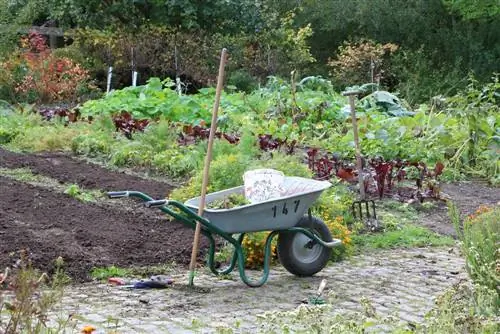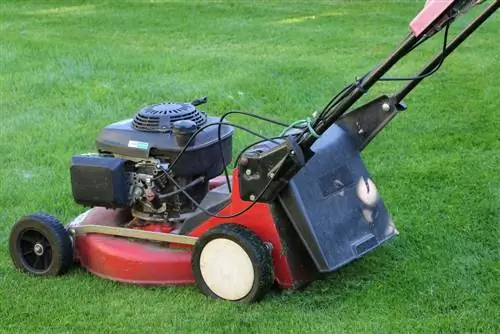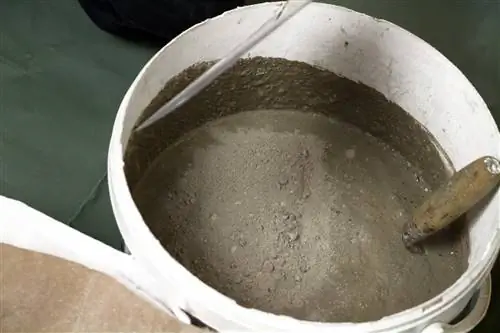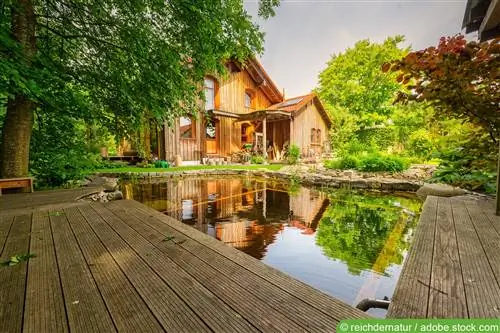- Author admin [email protected].
- Public 2023-12-17 03:39.
- Last modified 2025-06-01 06:48.
In this article, find out everything you need to know about the individual types of fences and their costs for purchase and installation.
Large selection for numerous applications
Fences are available in an enormous selection of designs. However, there are only a handful of materials that are used for fences today. A breakdown from expensive to cheap can look like this:
- Forged fences
- Stainless steel fences
- Functional fences
- Wooden fences
- Bar fences
- Wire Mesh Fences
- Forged fences
Wrought or cast iron fences
- are basically individually manufactured elements.
- They offer a heavy, representative quality.
- Prices for hand-made wrought iron fences.
- Only delicate, mass-produced products are available for less than 100 euros per meter.
- They are also very low at 50 cm.
- As soon as higher demands are made, the wrought iron fence quickly becomes very expensive.
- But they are virtually indestructible and require hardly any care.
- The doors and gates are particularly expensive when it comes to wrought iron fences.
- They cost from 600 euros for a single pass.
- Depending on the design and width, a car passage can cost up to 4000 euros.
Stainless steel fences
Stainless steel fences are the more modern version of metal fences. They are even more durable than the forged fences. Wind, weather and road s alt have virtually no effect on this material. They are also very representative even when uncoated. However, the basic material stainless steel is the most expensive thing you can find for building a fence:
- A fence panel in the simplest and lowest version costs from 150 euros per meter.
- The doors and gates on stainless steel fences are also particularly expensive.
- A simple gate costs around 1000 euros.
- You can also expect 2000 to 3000 euros for a car passage.
Stainless steel fences, however, have one crucial disadvantage: they are very popular with metal thieves. If a stainless steel fence is to be used, comprehensive security against accidental dismantling is mandatory!
Functional fences
Functional fences are fences that have an additional function. This includes, for example, noise protection. The noise protection fences of the same name consist of two meter high elements. They are made of a composite material, which can provide good protection against street noise. They also offer complete privacy and can serve as shade.
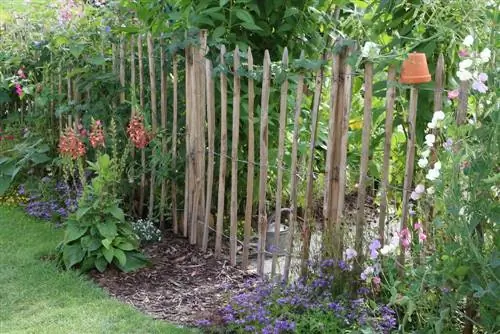
Although they are not made from materials as durable and high-quality as stainless steel, functional fences still have their price.
Soundproof fences made of WPC plastic-wood elements
They are delivered in panels of 180 x 100 or 180 x 180 cm. The advantage of WPC fence elements is that they consist of pluggable tongue and groove panels. This makes construction quite easy. However, attention should be paid to quality here. Offers that are too cheap are usually not very durable and are also very fragile. If they are of usable quality, they cost from around 190 euros per meter.
Soundproof fences made of wood and rock wool
The wood-rock wool variant is slightly more effective in soundproofing. It is also more decorative. The visible wood gives the fence a more natural appearance than the plastic of WPC fences. Standard market prices are:
- Wooden soundproof fences from 250 euros per meter
- Soundproof fences made of wood and rock wool from 380 euros per meter
Green soundproof fence
A green soundproof fence maximizes an ecological and pleasant appearance while maintaining high functionality. The fence can be covered with suitable plants. This lowers the temperature in the area, improves the air quality and makes a very high-quality impression.
Green soundproof fences cost from 300 euros per meter
Wooden fences
Wooden fences certainly represent the largest selection of fence types. Their range is correspondingly large. A wooden fence can be made from scrap wood with virtually no material costs. The sawmill residues, which you can get almost free of charge at the sawmill, are suitable here. They create very rustic and simple fencing with a characteristic western atmosphere.
Decorative privacy screen elements made of wood can cost 300 euros per 2 x 2 meter element
There are numerous variations of wooden fences. Here is a small selection:
- Palisades: 40-250 euros per meter complete with posts, depending on height, thickness and opacity
- Wooden privacy screen: Up to 500 euros per element of 180cm width, depending on the decorative design (round arches, inlays, peepholes)
- Hunter fence (scissor fence): From 30 euros per meter
- Larch picket fence: From 80 euros per element of 180 cm.
Bar fences
Bar mesh fences cost from 180 euros per meter element.
chain link fence
The chain link fence is available from 1 euro per meter. This makes it the cheapest way to fence your property.
Observe building regulations

A fence is a design element on a publicly visible building. The municipalities therefore often specify what a fence should look like, at least on the street side. Not everything is allowed here. When it comes to fencing in particular, municipalities are usually very consistent in implementing the requirement for dismantling. This is not only annoying, but above all very expensive. Save yourself these unnecessary double costs and find out beforehand how you can fence your property. If you have valid reasons for special requests, get them approved in advance. Obtaining approval afterwards is usually very difficult.
Assembling the fence - step by step
1. Step: The measurement
You need:
- Sledgehammer: Approx. 30 euros
- Post: Approx. 5 euros/piece
- Tape measure: Approx. 40 euros/100 meters of tape
Once you have decided on a fence type, the measurement begins. To do this, drive a post into the ground at each corner of the fenced area.
You should put a lot of effort into this:
A round log with a point and 15 cm in diameter should be rammed into the ground at least 30 cm deep with a sledgehammer. Only then will the measuring line stay where it should be.
Tip:
A little trick should help you measure a large, rectangular piece of land exactly straight: You now finally have the opportunity to apply the Pythagorean theorem. Using the calculator and the simple formula a²+b²=c², you can quickly find the exact points where you need to place the corner posts. Before you start, check your result: The diagonals in a rectangle must be the same length, otherwise you have miscalculated and the fence will definitely be crooked!
2. Step: Unbracing
Now stretch a string from post to post. Use sturdy masonry cord for this. You can put it under high tension, it won't tear easily.
The costs for this are:
- Mason's cord: approx. 15 euros per 100 meter roll
- Post: Approx. 5 euros/piece
3. Step: Mark point foundations
The longer the posts are apart, the easier it is for the taut cord to slip and bend in the middle. Therefore, start in the middle between the two corner posts and mark the point foundations. Round wood such as pointed broom handles or reinforcing rods made of structural steel are best suited for this. They are easy to stick into the ground. However, use marking sticks that are as uniform as possible.
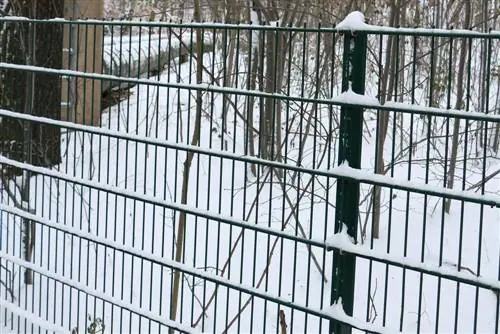
The distance between the bars must correspond to the width of the fence elements. Even if you want to install a chain link fence, make an effort to set the posts as evenly and straight as possible. It simply looks much neater afterwards. Always check that the markings for your point foundations are straight.
You need:
Reinforcing bars or thin round timbers: approx. 10-20 pieces/1 euro
Measuring the property is quite time-consuming. A construction company would charge at least a full man-day for this. This corresponds to around 350 to 500 euros. You can easily save this money if you take a Saturday to do this.
4. Step: Set point foundations
You need:
- 1x spade: Approx. 15 euros
- 1x round shovel: approx. 15 euros
- if applicable Auger (for long fences) (100 euros/day)
- Gravel: Approx. 30 euros per ton
The hole for the point foundation is now dug at each marking. Normally a spade and a flat shovel are sufficient for this. For long fences, the ideal tool for this is the earth auger.
For small point foundations with a narrow diameter, a device that you can rent for 100 euros a day is sufficient
They come in different sizes. With a one-man device you can only set small foundations. For demanding fences you need a tractor with an attachment. The farmer in your area is usually happy to help you for a small fee. The bottom of each point foundation is covered with a layer of 10 cm gravel.
The shorter the fence, the more expensive a construction company is. In any case, you will have to pay for the journey.
Half a man-day at 300 euros is certainly necessary for even the shortest fence
The longer the fence, the more worthwhile it is to use heavier equipment, such as a mini excavator.
5. Step: Fill point foundations
You need
- 1x trowel: approx. 10 euros
- 1x concrete tub: approx. 10 euros
- Concrete in bags or as gravel and cement (bags from 7 euros, cement 7 euros per bag)
- Slats: Approx. 1-2 euros
- Mixing machine for many point foundations From 150 euros or 20 euros per day to rent
You don't necessarily have to form the point foundations, but it is an overall cleaner and tidier approach. Sawn PVC pipes are ideal for setting point foundations.
With inner tube?
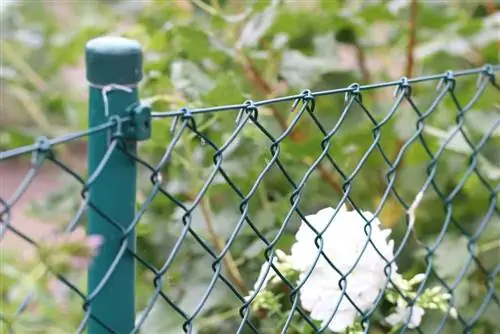
To this day it is absolutely common practice to set the fence posts directly into the concrete. However, this has the following disadvantage: If the post has rusted away after a few years, the foundation must also be replaced. However, when concreting you have the option of equipping it with an inner pipe. The fence post is then inserted into this inner tube. This maintains maximum flexibility and makes subsequent repairs all the easier. The extra work and additional costs are so small that you will be grateful for it later.
Tip:
Calculate the amount of concrete you need in advance. It is best to combine the placement of point foundations with other concreting work. Then the effort is much more worthwhile and you can also save money: Mixed concrete yourself from gravel and cement is significantly cheaper than buying bags of ready-made concrete. The mixing ratio of cement to sand is 1:4. But it also depends on the quantity: If you want to set point foundations under 20, stick with ready-made concrete. It may be worth mixing it yourself.
6. Step: Set the first element
You need:
- A fence element with two mounted posts
- 1x angle spirit level: approx. 10 euros
- Slats
- Cable ties
The post is either placed directly into the concrete or inserted into the prepared inner tube. It is important that the bottom of the post rests on the gravel bed. This means that incoming rainwater can seep into the ground. This means that the post does not rust from the inside so quickly. The post is aligned precisely using an angle spirit level and fixed with battens and cable ties. It is very important that it stays still while the concrete hardens!
7. Step: Install elements
If you have worked neatly and straightly, installing the intermediate elements is very easy. They are connected to the intermediate posts according to the manufacturer's specifications - your new fence on the property is ready.
Fence installation prices
Overall, installing the fence is one of the easier jobs. With a little courage and skill, a home worker can do this job very well on their own.
For a craftsman you can expect to pay €50-70 per hour
It therefore depends on which type of fence is installed. Here is a small list of typical prices for ten meter fencing with professional installation:
- Open wooden fence: 300 - 600 EUR material costs + 1000 EUR construction costs=1600 EUR total
- Privacy fence wood: 700 EUR material costs + 1000 EUR construction costs=1700 EUR total
- Plastic fence: 4000 EUR material costs + 1000 EUR construction costs=5000 EUR total
- Plastic privacy fence: 3500 EUR material costs + 1000 EUR construction costs=4500 EUR total
- Double rod mats: 1500 EUR material costs + 1000 EUR construction costs=2500 EUR total
- Wrought iron: 4000 EUR material costs + 1000 EUR construction costs=5000 EUR total
- Wire mesh: 400 EUR material costs + 1000 EUR construction costs=1400 EUR total
Peace behind the soundproof fence
Solid fence types such as acoustic protection fences are of course much more expensive.
- The elements, which are also sold as noise protection fences, cost between 250 and 1200 euros per segment.
- In addition, there are the costs for the intermediate posts and the foundations.
- After all, one segment is 240 cm high and about 300 cm wide.
You can effectively fence in a large area with just a few modules. These highly effective noise barriers are now available in an ecologically harmless design. They are available from solid wood, from mixed wood materials and from recycled plastic. Each variant offers maximum weather resistance and can be designed in any color. Their structure is quite simple. It is based on the proven system of point foundations and posts.
Since these fences are also opaque and also offer a large attack surface, the wind pressure must also be taken into account. The large soundproofing elements act like sails that constantly tug on the foundations. A particularly stable design is required here, otherwise the expensive elements will soon be left in the garden.
Skillfully combined for maximum effect
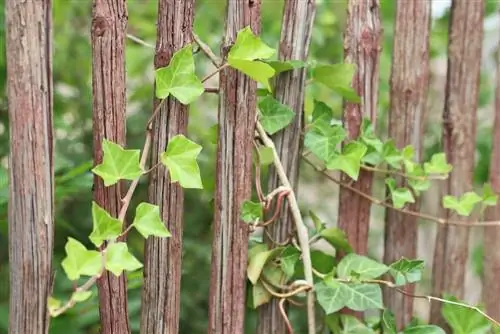
A cheap chain link fence is unfortunately not very aesthetic. With a simple trick, however, even these inexpensive solutions can be given a friendly face. A growth of a climbing plant quickly turns a chain link fence into an attractive appearance. Wild wine is best suited here. Its large leaves provide residents with an opaque barrier in summer. In autumn the leaves transform into a colorful spectacle of reds and browns. However, the large amounts of compost are part of keeping wild wine.
Conclusion
The question of the ideal fence for a property must be carefully considered. Many factors need to be taken into account. However, if it is clarified which tasks the fence should perform and what is permitted on site, the rest can be implemented quickly. The easy assembly of a fence makes it the ideal do-it-yourself project for do-it-yourselfers. You can rent the necessary tools and save a lot of money. Ultimately, the fence marks the end of the homeowner's private realm. The pride can clearly be shown by choosing a high-quality, self-built fence.


